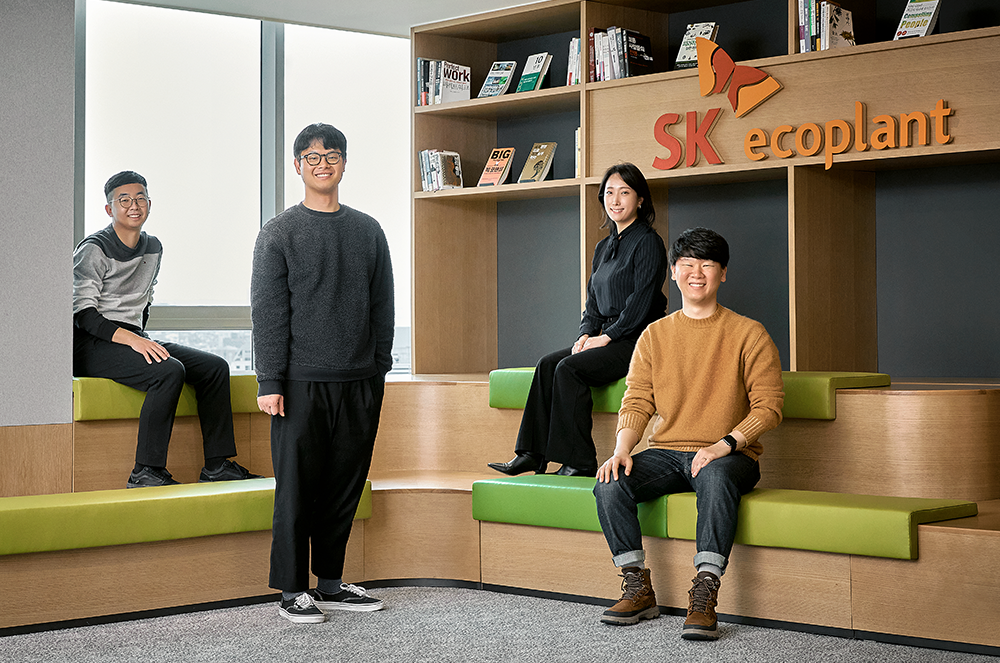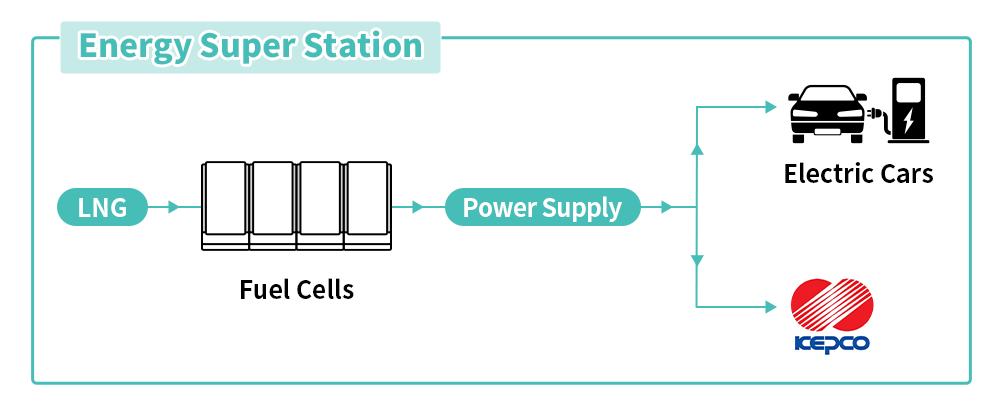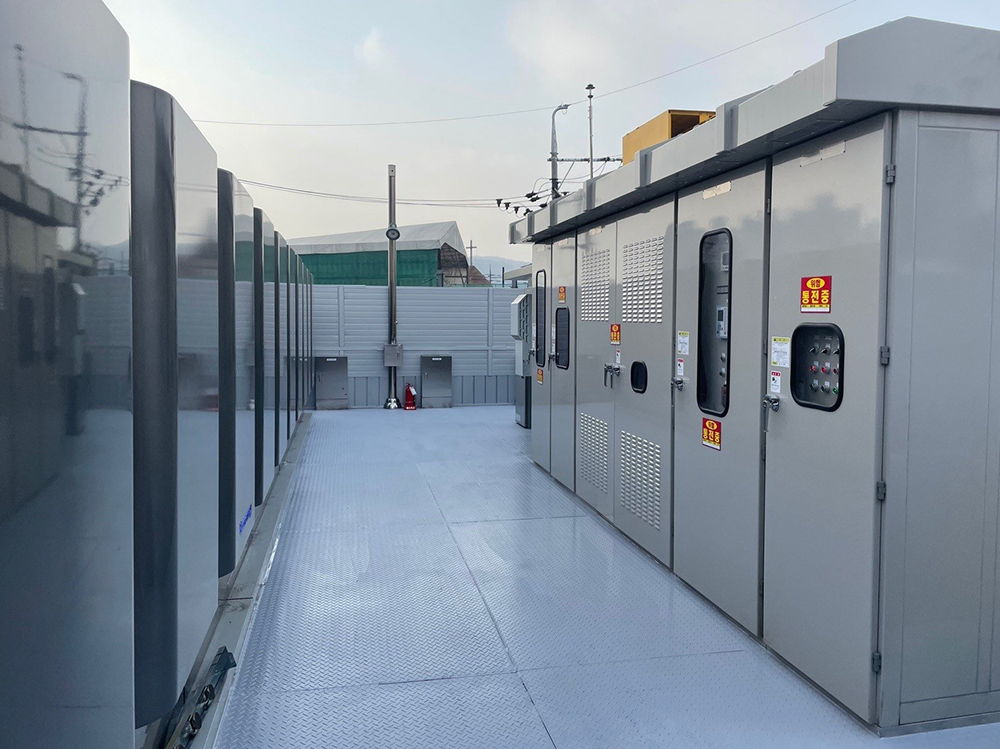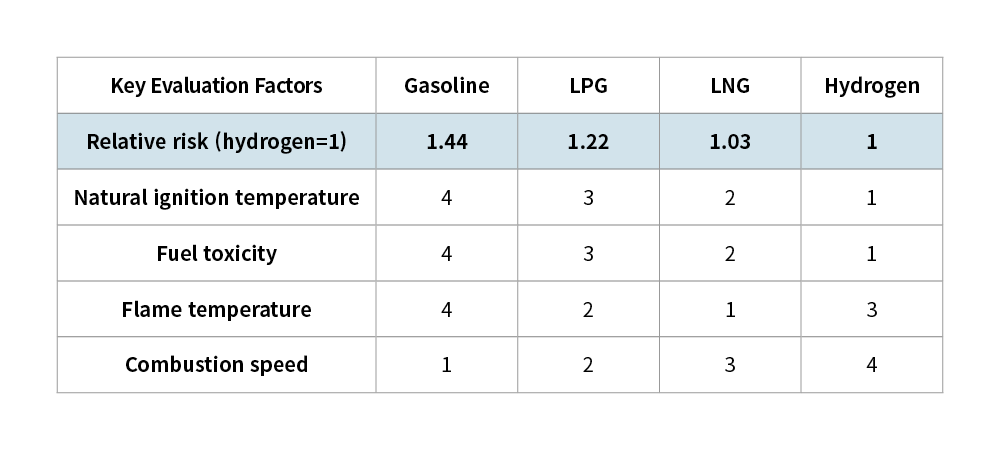Transformation: from a gas station to an urban, eco-friendly mini-powerplant! Energy Super Station
The nose-stinging stench of gasoline at gas stations may soon be a thing of the past. Here are the people behind the efforts to upgrade gas stations into ‘Energy Super Stations’ producing eco-friendly energy.

Eco-friendly cars are at the forefront of the next-generation, no, this generation of mobility. Cars such as electric cars and hydrogen cars are hailed as the fastest engine driving our transition to the Net Zero era. On the flip side, internal combustion vehicles running on oil and gas are facing the worst crisis in their 130-year history. This calamity is also seriously affecting another category of infrastructure: gas stations. When customers dwindle, it is a given that shops face the same fate. The case is easily found in Korea, where the number of gas stations in the country has declined by 100 to 200 every year between 2017 and 2022, from 12,007 to 1,0954(2022, Korea National Oil Corporation).
However, it is too early to despair. The country is witnessing the emergency of a new breed of gas stations-turned-Energy Super Stations, which build their competitiveness by producing eco-friendly energy. Now, let’s talk about Energy Super Station, the powerful driving force to lead us into the net zero era.

.
Looking for the best place for distributed power source systems? Look no further!

Energy Super Station is one of the main *distributed power source projects of SK ecoplant. The project installs fuel cells at gas stations to produce power, turning them into mini-powerplants. With electric cars expected to penetrate the market at an increasing pace, Energy Super Station is emerging as a breakthrough solution to address the charging station and power shortage issue as they can immediately supply power to electric cars only by adding charging stations.
However, there is an even more decisive reason for the attention focused on Energy Super Stations. They are expected to play a positive role in solving the power loss issue caused by long-distance power transfer, which has been a chronic problem in the Korean power sector.
* Distributed power source: unlike the conventional centralized power production, this approach uses small power production facilities distributed near areas that need power.
Q
What motivated you to launch the Energy Super Station project?
A
Oh Seong-taek (Oh): Most large power sources in Korea are located near coastlines. In other words, those power sources are located far away from the major areas of power consumption. We need many transfer and distribution cables and other facilities to take the power from those locations to city centers, which has resulted in the loss of considerable electricity(total loss reached 19,424Gwh in 2020 in Korea, which is worth around KRW 21 trillion / Korea Electricity Statistics). To address this issue, the Korean government plans to increase the percentage of ‘distributed power sources’ near city centers to 30% by 2040. And Energy Super Stations constitute one of the main pillars of the plan. Turning only 3,000 gas stations into Energy Super Stations is expected to result in a power loss reduction worth KRW 800 billion.
Q
There must be a wide range of options for distributed power source sites. Why gas stations?
A
Hong Bit-chan (Hong): I think gas stations are our best option to produce and use energy using distributed power sources. First, gas stations are perfectly located, because they are found across urban areas that serve as centers of transportation. It is difficult to secure new sites for distributed power source facilities. However, we can avoid this issue by utilizing unused patches of lands at gas stations. Another upside is that we can use local power grids without having to build additional transfer/distribution facilities.

Q
How far has the Energy Super Station project progressed?
A
Jung Hong-gu (Jung): The Act on the Safety Control of Hazardous Substances allows only certain facilities to be installed at gas stations, While fuel cells are not allowed. So, we launched a *regulatory sandbox project with SK Energy to install fuel cells at selected gas stations to prove that they are safe. After the project launch, we completed installation at Bakmi Gas Station in February 2022 and Gaenari Gas Station in September 2022 The gas stations are already selling what they produce to KEPCO. We are currently working on other gas stations including Singil Gas Station with the objective of completing the deregulation process this year. Moving forward, we will expand the scope of Energy Super Stations to include LPG charging stations.
* Regulatory sandbox: temporarily suspending the application of current regulations to deploy and verify products and services utilizing new technologies.
.
Gas stations and fuel cells… Are you sure they are not a lethal combination?
Energy Super Station represents the first distributed power production business in Korea where small-scale producers sell their power to KEPCO. SK ecoplant’s fuel cells have been chosen among numerous distributed power source systems for this monumental project because of one special reason; their outstanding energy density. A higher energy density means that the system produces energy more efficiently while occupying the same area. SK ecoplant’s solid oxide fuel cells(SOFCs) need only 1% of the space taken up by photovoltaic systems to produce the same amount of power. As such, fuel cells are the most suitable option for bustling cities and urban gas stations with narrow spaces.

At the same time, a probably more fundamental reason for the choice of fuel cells for Energy Super Stations in urban areas would be the fact that it uses chemical reaction between hydrogen and oxygen, which produces almost no pollutant or carbon. If all gas stations in Korea are transformed into Energy Super Stations with 300kW fuel cells, they will produce enough power to replace around ten coal-based power plants, and reduce CO2 production by around 140,000 tons.
On top of these benefits, the people behind Energy Super Stations emphasize another upside of fuel cells: they are, above all, safe.
Q
You are talking about hydrogen-using fuel cells at gas stations. Wouldn’t it be too dangerous?
A
Jung: The hydrogen used for fuel cells ignite at above 500℃, whereas gasoline catch fire at around 200℃, There is low risk of fire or explosion. Even if hydrogen is leaked, they quickly fly away because it is 14 times lighter than air. In fact, we can even say that hydrogen is safer than liquefied natural gas(LNG) that we use at home.

A
Kim Gi-seon (Kim): In particular, we use fuel cells called SOFCs at Energy Super Stations. They have all those components in a single box. Many other fuel cell systems consist of separated units, feeding hydrogen to the cells through pipes. To the contrary, our SOFCs supply hydrogen and produce energy in the box, which means greater safety. It makes our fuel cells all the more suitable for gas stations, where safety is key.

.
Signaling the arrival of virtual powerplants to lead the future!
If the government adopt more lenient regulations on fuel cell installation at gas stations, as expected, around 1,500 Energy Super Stations are projected to be erected across Korea by 2035(New Government’s Directio nfor Hydrogen Economy, 2022). The government is also pursuing a plan to build charging stations for more than 500,000 electric cars by 2025, raising the percentage of mandatory charging stations. Then, we may be able to see Energy Super Stations across the country sooner than we think.
However, these Energy Super Stations project and such achievements as the world’s first gas station SOFC are but a starting point of what SK ecoplant intends to achieve with Energy Super Stations.
Q
It has been a year since the first Energy Super Station went into operation. How is the progress so far?
A
Kim: Our largest achievement so far was that we proved the safety of our system by installing the fuel cell at highly-regulated gas stations and operating them without an incident. Through these efforts, we are lowering the regulatory bars and bringing changes to social norms.
In fact, the distributed power source market can hardly grow without government support. They takes similar resources and efforts to build as other larger powerplants, and produce far less energy, which means they are unlikely to be economically viable. We are proud that we are changing regulations and opening up a new market.
Q
What will Energy Super Station look like in the future?
A
Oh: I think they will become more complicated in the future. For example, we are planning a model where we install a solid oxide electrolysis cell(SOEC) with an SOFC to provide fuel for the fuel cells at Energy Super Station and use the produced hydrogen to fuel hydrogen cars. I believe that Energy Super Stations have endless potential.

A
Hong: I hope that Energy Super Stations can help us address the environmental and distribution issues caused by large-scale power production and long-distance transfer as well as the resulting social conflicts. On a related note, new frameworks called virtual power plants(VPPs) are spreading across the world, including Korea, which connects distributed power sources using ICT to operate them as a single powerplant. It will allow us to drive the efficiency of energy use, by sending remaining power to where it is more needed, or keeping the power. I believe that, when they are sufficiently mature, Energy Super Stations will play as a bridge for building VPPs.
Energy Super Station As unfamiliar as the name sounds, few countries int the world successfully combined distributed power sources with gas stations for successful commercialization. It means that these pioneers in the field have been through considerable hardship and trials. However, the members of the Distributed Energy Team grew more passionate as they talked about possibilities of the future, which raises our expectation for the future they envision. Let’s look forward to a new energy world to be created by Energy Super Stations and SK ecoplant.

연관 콘텐츠
Transformation: from a gas station to an urban, eco-friendly mini-powerplant! Energy Super Station

Eco-friendly cars are at the forefront of the next-generation, no, this generation of mobility. Cars such as electric cars and hydrogen cars are hailed as the fastest engine driving our transition to the Net Zero era. On the flip side, internal combustion vehicles running on oil and gas are facing the worst crisis in their 130-year history. This calamity is also seriously affecting another category of infrastructure: gas stations. When customers dwindle, it is a given that shops face the same fate. The case is easily found in Korea, where the number of gas stations in the country has declined by 100 to 200 every year between 2017 and 2022, from 12,007 to 1,0954(2022, Korea National Oil Corporation).
However, it is too early to despair. The country is witnessing the emergency of a new breed of gas stations-turned-Energy Super Stations, which build their competitiveness by producing eco-friendly energy. Now, let’s talk about Energy Super Station, the powerful driving force to lead us into the net zero era.

.
Looking for the best place for distributed power source systems? Look no further!

Energy Super Station is one of the main *distributed power source projects of SK ecoplant. The project installs fuel cells at gas stations to produce power, turning them into mini-powerplants. With electric cars expected to penetrate the market at an increasing pace, Energy Super Station is emerging as a breakthrough solution to address the charging station and power shortage issue as they can immediately supply power to electric cars only by adding charging stations.
However, there is an even more decisive reason for the attention focused on Energy Super Stations. They are expected to play a positive role in solving the power loss issue caused by long-distance power transfer, which has been a chronic problem in the Korean power sector.
* Distributed power source: unlike the conventional centralized power production, this approach uses small power production facilities distributed near areas that need power.
Q
What motivated you to launch the Energy Super Station project?
A
Oh Seong-taek (Oh): Most large power sources in Korea are located near coastlines. In other words, those power sources are located far away from the major areas of power consumption. We need many transfer and distribution cables and other facilities to take the power from those locations to city centers, which has resulted in the loss of considerable electricity(total loss reached 19,424Gwh in 2020 in Korea, which is worth around KRW 21 trillion / Korea Electricity Statistics). To address this issue, the Korean government plans to increase the percentage of ‘distributed power sources’ near city centers to 30% by 2040. And Energy Super Stations constitute one of the main pillars of the plan. Turning only 3,000 gas stations into Energy Super Stations is expected to result in a power loss reduction worth KRW 800 billion.
Q
There must be a wide range of options for distributed power source sites. Why gas stations?
A
Hong Bit-chan (Hong): I think gas stations are our best option to produce and use energy using distributed power sources. First, gas stations are perfectly located, because they are found across urban areas that serve as centers of transportation. It is difficult to secure new sites for distributed power source facilities. However, we can avoid this issue by utilizing unused patches of lands at gas stations. Another upside is that we can use local power grids without having to build additional transfer/distribution facilities.

Q
How far has the Energy Super Station project progressed?
A
Jung Hong-gu (Jung): The Act on the Safety Control of Hazardous Substances allows only certain facilities to be installed at gas stations, While fuel cells are not allowed. So, we launched a *regulatory sandbox project with SK Energy to install fuel cells at selected gas stations to prove that they are safe. After the project launch, we completed installation at Bakmi Gas Station in February 2022 and Gaenari Gas Station in September 2022 The gas stations are already selling what they produce to KEPCO. We are currently working on other gas stations including Singil Gas Station with the objective of completing the deregulation process this year. Moving forward, we will expand the scope of Energy Super Stations to include LPG charging stations.
* Regulatory sandbox: temporarily suspending the application of current regulations to deploy and verify products and services utilizing new technologies.
.
Gas stations and fuel cells… Are you sure they are not a lethal combination?
Energy Super Station represents the first distributed power production business in Korea where small-scale producers sell their power to KEPCO. SK ecoplant’s fuel cells have been chosen among numerous distributed power source systems for this monumental project because of one special reason; their outstanding energy density. A higher energy density means that the system produces energy more efficiently while occupying the same area. SK ecoplant’s solid oxide fuel cells(SOFCs) need only 1% of the space taken up by photovoltaic systems to produce the same amount of power. As such, fuel cells are the most suitable option for bustling cities and urban gas stations with narrow spaces.

At the same time, a probably more fundamental reason for the choice of fuel cells for Energy Super Stations in urban areas would be the fact that it uses chemical reaction between hydrogen and oxygen, which produces almost no pollutant or carbon. If all gas stations in Korea are transformed into Energy Super Stations with 300kW fuel cells, they will produce enough power to replace around ten coal-based power plants, and reduce CO2 production by around 140,000 tons.
On top of these benefits, the people behind Energy Super Stations emphasize another upside of fuel cells: they are, above all, safe.
Q
You are talking about hydrogen-using fuel cells at gas stations. Wouldn’t it be too dangerous?
A
Jung: The hydrogen used for fuel cells ignite at above 500℃, whereas gasoline catch fire at around 200℃, There is low risk of fire or explosion. Even if hydrogen is leaked, they quickly fly away because it is 14 times lighter than air. In fact, we can even say that hydrogen is safer than liquefied natural gas(LNG) that we use at home.

A
Kim Gi-seon (Kim): In particular, we use fuel cells called SOFCs at Energy Super Stations. They have all those components in a single box. Many other fuel cell systems consist of separated units, feeding hydrogen to the cells through pipes. To the contrary, our SOFCs supply hydrogen and produce energy in the box, which means greater safety. It makes our fuel cells all the more suitable for gas stations, where safety is key.

.
Signaling the arrival of virtual powerplants to lead the future!
If the government adopt more lenient regulations on fuel cell installation at gas stations, as expected, around 1,500 Energy Super Stations are projected to be erected across Korea by 2035(New Government’s Directio nfor Hydrogen Economy, 2022). The government is also pursuing a plan to build charging stations for more than 500,000 electric cars by 2025, raising the percentage of mandatory charging stations. Then, we may be able to see Energy Super Stations across the country sooner than we think.
However, these Energy Super Stations project and such achievements as the world’s first gas station SOFC are but a starting point of what SK ecoplant intends to achieve with Energy Super Stations.
Q
It has been a year since the first Energy Super Station went into operation. How is the progress so far?
A
Kim: Our largest achievement so far was that we proved the safety of our system by installing the fuel cell at highly-regulated gas stations and operating them without an incident. Through these efforts, we are lowering the regulatory bars and bringing changes to social norms.
In fact, the distributed power source market can hardly grow without government support. They takes similar resources and efforts to build as other larger powerplants, and produce far less energy, which means they are unlikely to be economically viable. We are proud that we are changing regulations and opening up a new market.
Q
What will Energy Super Station look like in the future?
A
Oh: I think they will become more complicated in the future. For example, we are planning a model where we install a solid oxide electrolysis cell(SOEC) with an SOFC to provide fuel for the fuel cells at Energy Super Station and use the produced hydrogen to fuel hydrogen cars. I believe that Energy Super Stations have endless potential.

A
Hong: I hope that Energy Super Stations can help us address the environmental and distribution issues caused by large-scale power production and long-distance transfer as well as the resulting social conflicts. On a related note, new frameworks called virtual power plants(VPPs) are spreading across the world, including Korea, which connects distributed power sources using ICT to operate them as a single powerplant. It will allow us to drive the efficiency of energy use, by sending remaining power to where it is more needed, or keeping the power. I believe that, when they are sufficiently mature, Energy Super Stations will play as a bridge for building VPPs.
Energy Super Station As unfamiliar as the name sounds, few countries int the world successfully combined distributed power sources with gas stations for successful commercialization. It means that these pioneers in the field have been through considerable hardship and trials. However, the members of the Distributed Energy Team grew more passionate as they talked about possibilities of the future, which raises our expectation for the future they envision. Let’s look forward to a new energy world to be created by Energy Super Stations and SK ecoplant.






